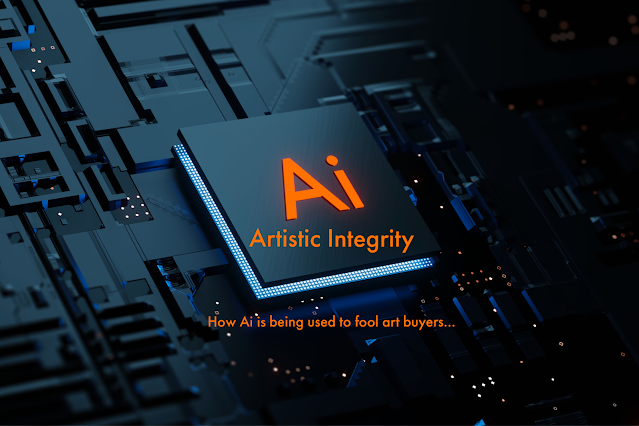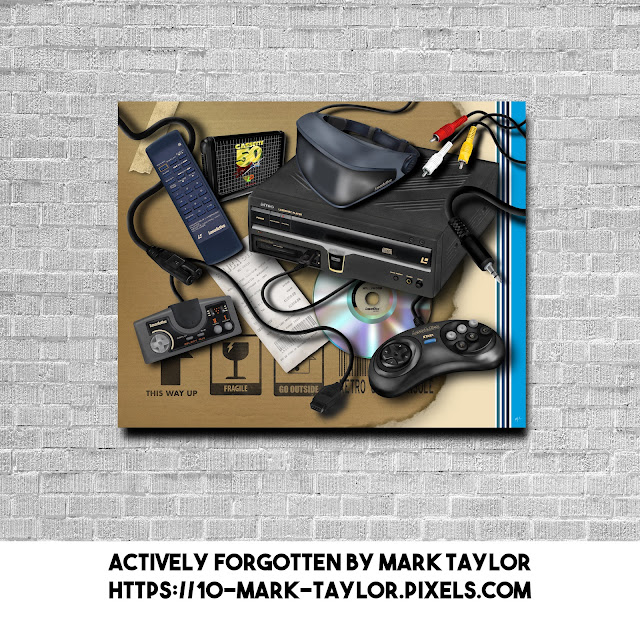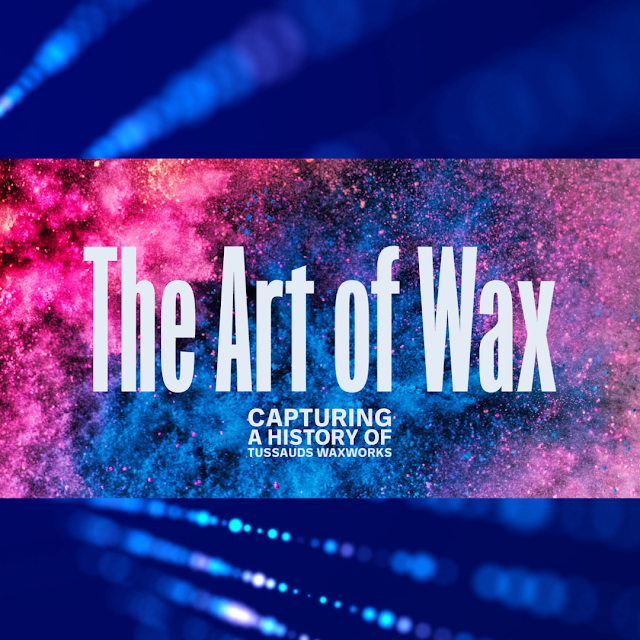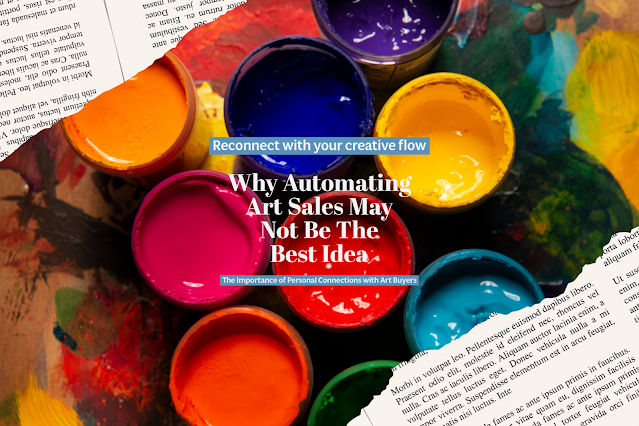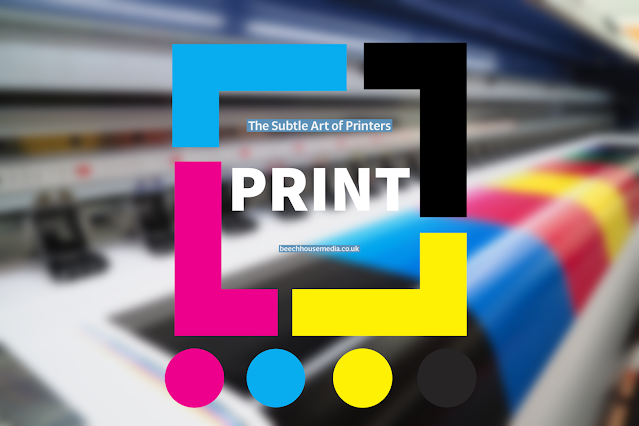How AI is being used to Fool Art BuyersHow Ai is being used to fool art buyers... The advent of Artificial Intelligence (AI) has undeniably brought numerous benefits to the art world, revolutionising creative processes and expanding artistic possibilities,...
How AI is being used to Fool Art Buyers
The advent of Artificial Intelligence (AI) has undeniably brought numerous benefits to the art world, revolutionising creative processes and expanding artistic possibilities, or at least thatís how the teams behind these engines are selling it. But, thereís also a dark side of exploitation and dishonesty that is beginning to blur both creative and ethical boundaries and thatís something that could have a long lasting effect on the art world.
The Other Side of the AI coinÖ
Whether AI really will turn out to be the force that completely displaces and disrupts entire industries is yet to fully emerge, and as much as I call out the pitfalls of depending on AI to take over the creative process performed by artists throughout this article, we need to remain mindful that AI can genuinely bring around positive change by becoming another useful tool that an artist can legitimately use in their business without risk or worry that the robot will replace them.
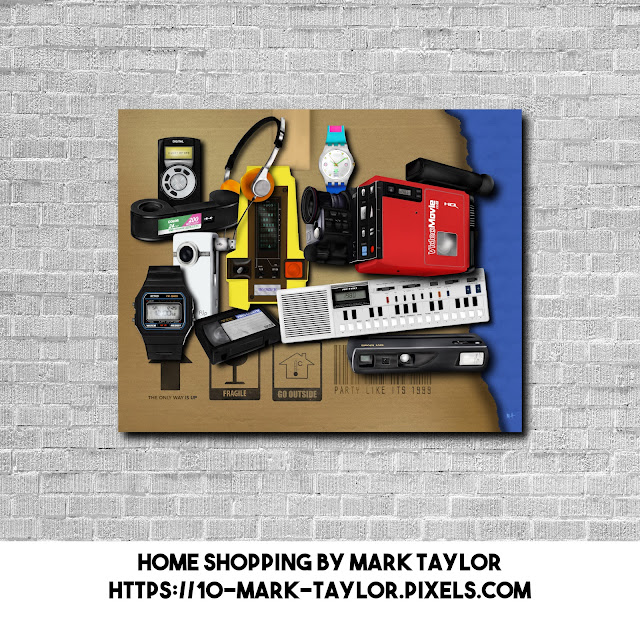 |
| One of my latest retro artworks - Proudly hand drawn using a digital medium and no Ai! |
Whether artists turn to AI for image generation, the development of new ideas and concepts, research, planning out work, or the multitude of business related things that creative types would rather see carried out by anything, or anyone other than them, AI, as much as we think we dislike it today, will be something that we will all need to better understand, or at least learn to live with in the future.
Iím not completely against AI, itís way better than I will ever be at generating titles, it can certainly refine the often odd sounding titles that frequently spring to mind midway through a work, and itís really helpful in figuring out the metadata labels that need to be applied to images being sold online so that they can be found through search engines. Using AI to do these things literally saves me about a day of admin each month.
Tasks such as search engine optimisation take so much time away from the creative process so using AI to at least lend a helping hand should be seen as a help rather than something that takes away a human role. Iím sure SEO specialists are reeling right about here, but most independent artists have very few or even no employees and they donít always have a budget for professional SEO services, so anything that can help them to focus on higher value tasks is savvy business practice rather than anything sinister.
I frequently use AI to help with search engine optimisation, something Iím comfortable with because 90% of my business doesnít come via the web, and Iíve started to take advantage of it more recently as a tool to reduce some of the administrative burden of running my business. It doesnít do everything for me, but it can be really useful for some of the small tedious and repetitive tasks that allow me some extra creative time. What I donít use it for is the creation of art, partly because I really enjoy the creative process and secondly, because AI art, well, it just isnít very good right now.
But something that can completely change the playing field for artists is beginning to emerge, and that is AIs role in more dubious business practices. Itís a dark side thatís becoming more common and it happening more frequently lately, itís even celebrated through click-bait headlines on the web that tells us how a side hustle artist/author made mega-money through selling AI work that took little to no effort to create. Great if you donít subscribe to any code of ethics I guess.
Thereís certainly a trend right now of inexperienced non-artists and even would be authors chancing their arm at an art career or more specifically, an art or writing related side hustle. Theyíre probably thinking that creativity is a well paid and easy, work from home vocation. Experience suggests that itís neither truly a work from home vocation, and itís definitely not easy, and as for well paid, well someone is making money in the art world but from experience of the past four decades, the real money is made in the secondary art markets.
The use of AI to generate art which is then offered for sale to the art buying public transitions from something fun to becoming an issue when it comes to freelance work or quality control. The speed that AI can generate work means that markets can become flooded with sub-par work very quickly, and because the work takes little to no time to create, it also makes it incredibly inexpensive to create.
 |
| Forgotten Play Days - Part of my forgotten consoles series of works. Again, no Ai here folks. Just time, lots of time... |
Weíve seen this before with print on demand services offering batch uploads across pre-built templates. Sure you can have a keyring with my badly cropped image of a stolen positive quote in red, green, blue or yellow, hey, you can even have it on a Sippy cup. Makes me sound like some art purist, but we should at least expect some element of quality control in the art world. Just because you can, doesnít mean you should, youíre diluting the market including your own.
Not everyone who buys art spends the kind of money that might be stereotypical of the sales figures recorded in the media whenever art sells for millions of dollars. A lot of art is affordable, the markets for inexpensive home dťcor art are fundamental to the success of many independent sellers who use store fronts such as Etsy. This kind of art market is a high volume business, it also collectively generates more income than the fine art markets where the multi-million dollar works are sold, but the overall income is then devolved to multiple artists.
Thereís also a growing number of relatively well established artists who have decided to utilise AI image generators without disclosing to their potential buyers that the image has been created using AI. Ethically and morally, Iím not convinced this is the right way to go, it feels completely disingenuous to exchange art for money under a misconception that the work had been created by the artists hand. Artistic integrity should be the foundation on which art careers are earned and this opaqueness is further muddying an industry that already has its fare share of trust and integrity issues. So there are some challenges in the art world when it comes to AI but as AI models mature, maybe the real challenges are yet to emerge.
A Brief History of AI Art GenerationÖ
Art created using artificial intelligence is often predicated on the end user typing some simple text descriptions into a web page or application and allowing the AI engine to generate an image based on whatever dataset or multiple datasets that have been used to teach it, but it wasnít always done like this.
Art produced using AI isnít something that is entirely new. Early AI models appeared back as early as the late 1960s, with the first system of note being debuted in 1973. That system was Aaron, developed by Harold Cohen, a British artist (1 May 1928 Ė 27 April 2016). Aaron was a computer program with the specific purpose of generating what at the time was called, autonomous art. When it arrived it gathered a great deal of attention and it was displayed in a number of exhibitions at various museums and galleries, including the Tate Gallery in London.
The difference between Aaron and modern day AI art generation however, is significant in that modern AI image creation is accessible to virtually anyone with an internet connection and a keyboard and there is no requirement on the end user to even begin to fully understand how it all works. There are very few barriers and the price of entry into the space starts at the princely sum of free.
There were plenty of barriers in the late 60s. Aaron had been literally created by Cohen and a level of skill in creating the model that then created the art was required. Today, the heavy lifting has been done by others and AI art creation for most people is little more than a single click of a mouse or entering some descriptive text.
Thatís really what sets apart some of todayís so called AI artists and Cohenís use of Aaron. Cohen did more than enter descriptive statements to generate the work, he essentially created the virtual brush and paper with a specific intent to create, what was at the time, something that hadnít been seen before. To some extent it could be said that Aaron was just as significant as the output it generated and was in itself, intrinsic to the end result.
Everyoneís an artistÖ
The introduction of modern AI tools has made it incredibly easy for anyone with a computer or mobile internet connection and five minutes to spare to generate what on the surface at least, looks like incredible artwork in the style of almost any artist in the history of art, ever.
Social media is awash with output from the latest tranche of apps and websites, all providing the user with an experience that needs little to no instruction to use it and in many cases, these systems are either available freely or at a minimal cost.
AI engines such as DALL-E 2, Craiyon, Adobe Firefly, and even Bing which can create images using just Microsoftís Edge Browser have become as well known as the phrase ChatGPT. Itís fair to say that the market for these kinds of applications has grown enormously over the past couple of years, and for most people, these systems are fun, but theyíre not really fulfilling the full potential that AI can offer, but I think thatís the point, if AI is to succeed in the consumer market you have to give consumers something that they can get on board with.
AI image generation is already exponentially more advanced than it was even six-months ago and the fast pace of AI development means that it will become even better in time. A point to bear in mind here is that to date, AI development has clicked along at a rapid pace, and just as weíre thinking that it will make some kind of exponential leap in the near future to give us what we think we really want from it, things might soon start slowing down in some sectors of the industry because the industry is facing a myriad of supply and demand bottlenecks that might not be all that easy to resolve quickly.
Those bottlenecks are already beginning to slow things down, driven by the demand for GPUs, CPUs and other components needed to train the AI models and run the data centres.† These chips and other components arenít even close to the consumer grade chips we recently experienced a global shortage of, these are ultra-high end, high-specification, massively powerful and much more expensive than the chips most people will be familiar with and even when theyíre more abundant in availability, theyíre not always that easy to source and procure. You donít tend to pick these things up from the local PC store.
People close to the supply and manufacturing side of the industry are already starting to hear the loud sucking sound of these high-end components are making as they fly off the shelves leaving a void with little to no stock available to replace it. The companies gearing up to move into AI in the future are already in the process or indeed, have already secured the components they need, or at least the savvy ones will have. The rest who have been slow to adapt, I think theyíre going to fall behind rapidly.
The issue now is the lack of production facilities with the capability to create new chips and when most of the demand is currently falling on a handful of manufacturers who are themselves struggling to secure the raw materials, itís a technology problem that could slow down the exponential leaps forward that weíve been seeing for the past couple of years.
Despite these supply issues, the pace of AIís development behind the scenes is happening so quickly that what we think of as ground-breaking today will looked massively outdated tomorrow, but it will be the supply of the technology that will be needed in the future that will ultimately be the determining factor in just how quickly we get to see any of these next generation AI systems anytime soon.
Given these bottlenecks we might even begin to see smaller AI models that rely on less computational power, and there is some wider benefit in that. Smaller models can be more focussed and bring better results, theyíre not as overly reliant on the latest technologies and theyíre generally less expensive and less environmentally draining to operate.
Thatís something else that could ultimately decide AIs fate. The current AI engines rely on having access to lots of power and consumers are beginning to ask questions and become more focussed on companies carbon strategies. As governments race towards net zero targets, itís unclear how well most of these large AI models will perform environmentally in the future and the hype train for AI, at least right now, seems to have overshadowed the burning question, how do you make AI more environmentally friendly?
Smaller AI models might be the answer to some of the environmental questions and there is also that wider benefit in that they can also be trained on very specific datasets. These models already exist today for things like medical and scientific research, and the results that those models generate are generally laser focussed on providing a specific outcome, which also means that the best ones are usually very good and very accurate and massively more efficient than the lar datasets that more generalised models use.
The issue with large data sets and AI engines which are designed to be everything to everyone, is that they then have to be massively scaled and when you scale technology, a conversation has to be had around just how sustainable this technology is, not just today, but in the future too. Technology at scale doesnít always offer savings in either money or power.
AI will need to evolve not just in providing iterative jumps that make the models more adoptable, but it needs to evolve in terms of the computational power and energy consumption these models require. It certainly needs more efficient algorithms that are less reliant on using as much power as they need today. Better algorithms that are more efficient can have a significant impact on whatís actually needed to run these systems and one of the problems often seen with developers is that they have become overly reliant on resources and they create less efficient code. Go back to the 80s and look what companies like Atari did with just 4K of RAM, thatís the kind of efficiency that will be needed again.
The promise of Quantum Computing will ultimately have the potential to solve complex problems with less computational power and it could deliver better results faster, but the promise of mass quantum computing is far from being fulfilled anytime soon, certainly in a way that makes it affordable to those who might get the most benefit from it. Weíre in the midst of a global economic crisis and science budgets are being cut.
Designing specialised hardware tailored for AI tasks, such as application-specific integrated circuits (ASICs) or field-programmable gate arrays (FPGAs), can greatly improve energy efficiency. These chips can be optimised for specific AI workloads, reducing the need for general-purpose computing resources and their use reduces the energy needed for tasks to be completed, but the issue here isnít that the technology doesnít exist, itís that the manufacturing process is carried out by so few companies. You only need to look at the cost of a Terasic DE-10 Nano board to know that thereís a supply and demand issue with FPGA.
I suspect that in the future we could begin to see some of this specialised hardware evolve into Neuromorphic computing technologies, a technology that aims to mimic the brains structure and function. This is a technology that can lead to highly energy efficient AI systems, but itís really complex. The idea is that these systems can process information in a more parallel and adaptive way, similar to how the human brain works. The downside is that engineers and researchers with expertise in neuromorphic computing are relatively rare, which drives up the labour costs associated with developing and maintaining these systems. Efficient it might be, but itís also incredibly expensive when the expertise needed to operate and build the model just isnít in place and no one seems to be doing much in the academic space to encourage people into the industry.
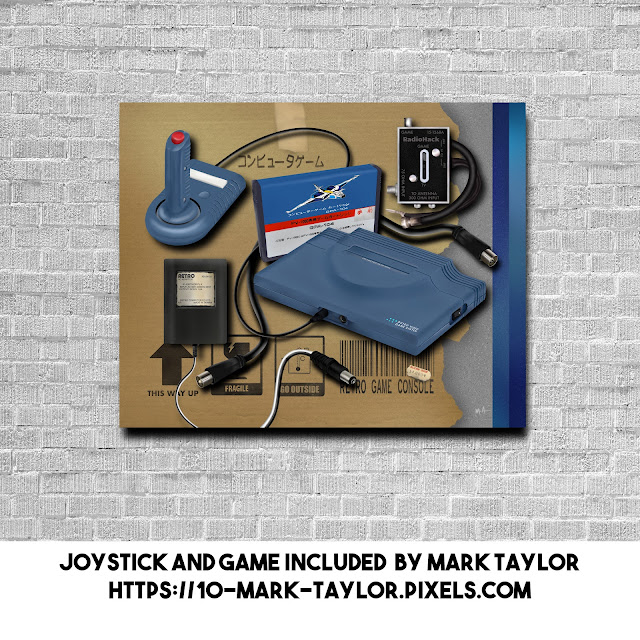 |
| Joystick and Game Included by Mark Taylor - another retro work and another forgotten console from the 80s... still no Ai... |
There are other ways in which AI could become more efficient and more environmentally acceptable than it is today, but the models powering the AI will need to adapt. †Techniques like knowledge distillation will eventually need to be used. This involves training those smaller and more efficient models I spoke about earlier to replicate the behaviour of larger models. Model pruning, on the other hand, involves removing redundant or less important parts of a model. Both approaches reduce computational demands without sacrificing performance and both models require less computational power, and less energy to function.
Another way that AI might begin to address some of the power and component issues is by doing the exact opposite of training smaller datasets. Transfer and Few-Shot learning models involve large datasets that are then fine tuned for specific tasks with smaller datasets. Few Shot Learning goes beyond this, it is trained on models that contain fewer examples meaning less power is needed and the theory goes that smaller, more focussed training sets will provide far better results on any specific subject that it has been trained on.
Data Centres are another incredibly expensive resource, anyone who subscribes to a cloud storage account will have seen at least an element of shrinkflation, less product for a higher price, and with many cloud storage providers realising that energy costs are significantly higher lately, the general trend has been to reduce the amount of storage available to end users while usually increasing the price they pay. Not all that long ago we were inundated with free unlimited cloud storage offers, today those products have limited the space and most of them now charge a kings ransom for anything useful.
To get better, data centres themselves need to become more efficient, particularly those that deal with AI engines. They really need to be laser focussed on renewable energy to power them and they also need better and more efficient cooling for the vast amount of computational power that inevitably generates more heat.
Where AI models are replicated, we have to bear in mind that the power needs exponentially rise. Developing AI systems that dynamically allocate resources based on the task's complexity can prevent overutilisation of computational power. This could involve scaling down resources during low-demand periods and making sure that high use periods happen only when energy consumption is generally lower and more affordable.
To achieve some level of environmental nirvana, it really needs some collaboration to happen far more than it does across industries and research institutions. Collectively, if they can accelerate the development of energy-efficient AI technologies by sharing knowledge, resources, and best practices it could lead to faster advancements, but everyone in the AI space right now seems to be focussed on being first past the post where the short-term financial rewards are going to be higher. The problem with this approach is that development will eventually crawl and it will ultimately be more expensive both in a financial sense and even more so, in the environmental impact it will have as the technology becomes more abundant.
Ultimately, achieving a more environmentally friendly AI involves a combination of innovation in algorithm design, hardware development, energy-efficient infrastructure, and responsible decision-making by AI practitioners. As AI continues to evolve, a concerted effort towards sustainability will be essential for minimising its environmental footprint and thatís another point to remember the next time you fire up the latest AI image generator, it might save you creative time and it might create passable art that sells into a short-term, trend following yet, shallow market, but the environmental impact alone if everyone is doing it, should raise some strong moral and ethical questions. Iím not sure as an artist that you could even begin to claim that you are environmentally sustainable if you rely on masses of backend power, even if youíre not paying for it and art buyers are definitely becoming more environmentally astute.
Spotting when AI is being usedÖ
I suspect in time, AI will become smart enough for us to be unable to distinguish whether something was created using AI or not, and that could compound some of the issues we see today when AI is used but not disclosed. †Today, making the distinction between AI and human art is possible with some visual training, but we shouldnít take it for granted that it will always be the case. AI is relatively still only at the start of its journey.
Even today, the images created by AI are a huge leap from the days of Aaron, some of todays output is even passable as artwork that wouldnít entirely look out of place in a gallery with some subjects looking almost indistinguishable from those drawn or painted by human hands. Theyíre certainly a long way away from the neural network images that became popular among mobile users in around 2016, an idea that created abstract works based on photographs and images you had supplied and uploaded into the apps and very much a precursor to the technologies that we are seeing today.
But, there are some limitations with todays AI which to the casual viewer might not be immediately visible. Once you develop a slightly better understanding of AIís current image creating limitations you begin to notice the cracks and the similarities that exist between AI works.
Thereís the lack of detail and the distortions for a start, flaws that just wouldnít be present had the work have been created by a human, even an inexperienced human who has rarely created art. The flaws look like computational errors which would, almost ironically, be very challenging for a human to create with the same effect. At the moment, so long as you have some basic knowledge of how AI images are structured and generated itís relatively straight forward to determine when something is and isnít using AI.
If you are aware of the limitations, itís possible even with a small amount of visual training to spot images created by AI, particularly images created with the more recent AI engines such as Adobeís Firefly and DALL-E 2. If you have been exposed to human produced artworks over the course of an art career, the task of identifying AI becomes even easier.
AI images tend to also lack the emotion that will be more obvious in a work created by a human. AI can create some pretty soulless creations at times and weíre maybe, even with the pace of current pace of change in the technology, still half a decade or more away from AI that can replicate some of those personal nuances that humans bring to a work of art. Remember, AI is trained on data sets that have no idea of context from a human perspective, thatís also why we see so much bias occurring in some of AIs output. What comes out of AI is only ever as good as what goes in, in this case, the data the AI is trained on.
When it comes to AI image generation, today it feels like a by-product of everything else that AI can do. As it evolves, for artists, it will eventually serve one of two purposes, it will either help enormously with the creative process or it will become the force that displaces an entire industry, which road it takes will be largely determined by how artists begin to embrace it, or move away from it, and to some extent, the publicís acceptance of AIs role in creating art.
Why canít AI draw hands?
One of the big problems with AI image generation today is that it relies on what Iíve come to term as the billboard effect. When you look at an image created by a human, be it a photograph or some other image, what you look at tends to be in high resolution. Mostly, printed images are created by thousands upon thousands of small dots printed by an inkjet printer or represented by pixels on a screen. In short, most images that you will be familiar with, have detail that is clear even when looking at the images for a prolonged period of time.
Billboards can be printed using very low resolutions, these images are created with far fewer dots and nowhere even close to having the same level of detail that would be found in a fine art print. The billboard images work because weíre viewing them, often only briefly, from a distance away.
Once we get around 650 feet away from an image, our eyes can only resolve around one pixel per inch. While 300 dots per inch seems to be the golden rule for print resolution, in truth, itís not a super helpful number that can be applied to everything and it also makes prints more expensive to produce. But, it is an accepted standard that reproduces the detail needed for the best fine art prints, itís also unforgiving for artists because at that resolution, any discrepancies in the work are easier to spot.
A billboard is usually printed at 15dpi, the advertising on the side of a bus is usually no more than 72-100dpi, and many fine art prints are usually printed at 240dpi, although I do tend to stick to the regular 300dpi because I put so much effort into creating intricate, even small details into my retro works and some of the prints I offer are sold at a size that would be large enough to notice the difference up close. †AI models found online are usually creating work at a screen resolution of somewhere in the region of 72 dots per inch. In short, not really good enough to hang on the wall.
So, when you look at low resolution images on a billboard from a distance you are doing the heavy lifting by resolving the missing detail. You generally only ever view a billboard for a short period of time and you are usually standing too far away to be able to view any detail even if it was present because of the shortcomings in not being able to process more than about one pixel per inch from a distance.
With AI images, itís kind of the same thing. Itís an approximation of an image, but get up close and study it for a few seconds longer and the cracks begin to show. We might stumble across AI images in the news or online, both of which would be providing us with images that have much lower resolutions than would be expected from a fine art print, but we will usually move on much more quickly than if we were viewing a high resolution artwork that has been professionally printed and hung on the wall at home or in a gallery where weíre also closer to the work. AI image generation is more smoke and mirrors than we might initially think it is.
AI simply doesnít do detail very well when it comes to images. It also struggles with other things too, so we will often find misquoted information or information that makes no sense and it hallucinates more than a hippy on a mushroom trip at times. When AI is focussed on a particular task and is less generalised, it tends to perform way better, hence medical research which is predicated on learning from those very specific small data models, which also make it generally much better and faster than a human.
When AI becomes part of a consumer facing system that tries to be everything to everyone, it struggles. In part, unlike humans who are usually inspired by reality, AI is inspired by whatever dataset it has been trained on and it literally doesnít know anything else. At best, this means that it can only ever create an approximation or reproduction because it has no real context or reality to base the output on. Until the issues of context and emotion are included in the data sets, I think AI art will continue to struggle because there will be missing data and missing detail that humans understand because they have life experience to baseline it on.
If you look at AI generated hands, they tend to be deformed for one reason alone, the datasets containing the images used to train the AI will be more likely to have featured faces, and faces tend to be much more prominent than hands when you look through any photo collection.
That said, if we look at how much hand generation has improved even since the beginning of this year, we are now getting to a point where even hands are becoming more identifiable as hands. Itís not that AI is getting better, itís that the data sets are getting bigger and more varied. There are still plenty of tells though, the occasional extra thumb, hands appearing in an anatomically incorrect place, these are the tells that AI is being used.
Unnatural textures, either too smooth or perfect or that donít look quite right or are shown in the wrong context can also be an obvious tell, as can plastic-like skin and unnatural skin tones, or the ultimate giveaway this month, retro-futuristic colour palettes. When recreating materials, often the materials will look overly uniform, there may be no creases or shadows. If there are obvious brush strokes, look for replication of the same brush stroke within the image, this would imply that a digital brush algorithm is being used.
There will be other inconsistencies or objects that appear to be out of place, any light refraction included in an original photograph used to train the AI is likely to still be present in the output and it is often represented by weird black dots and lines. Lighting is another giveaway, a human artist will instinctively know that reflections are generally uniform and light is cast often from a single point, especially in landscapes when either the sun or moon is the light source, AI generally doesnít understand how to render light sources that well so it casts misplaced shadows and reflections.
If you zoom into the image, you might notice unnatural poses and expressions, stark colour changes that make no sense, artifacts left behind from the original source, pixelation in some or all areas of the image, or an halo effect that looks like it should be fixed with an application of gaussian blur in Photoshop. You will especially see this in fake images of anything usually in flight. UFO photographs can often be debunked within seconds when AI has been used.
Another giveaway is that the composition of the image tends to be disjointed, or the image may be unnecessarily cropped in a way that makes little to no sense. Artists are usually taught composition or they will pick it up as they gain experience, AI has certainly got a way to go before composition becomes natural, partly because it has no reference or context other than the training images it has been trained on. Size and scale are difficult to comprehend in a photograph unless you have some other context or other point of reference.
Repetition and unnatural patterns are another area where AI struggles. Misaligned repetition of a pattern is often the first clue, but also look out for patterns that would first appear to fit together if they were to be realigned, but would then still not match perfectly. AI, is still incapable of creating perfection.
You might also want to conduct a reverse image search of the image in its entirety and sections of it. †The reverse image algorithms will be typically looking at the same reference photos online that had been used to train the AI, so itís relatively easy for them to pick out elements of an image that may be from another artists work.
Itís also worth looking for the artists signature, if itís present and in the usual place (most artists will sign their work in the same way, usually in the same area of their work), you should look for smoothing of the area where the image looks like it has either been healed or cloned from another section of the image. In instances where the signature or watermark has been removed smooth areas tend to mean that the image has been manipulated and sometimes the area looks as if it has had a section of the surrounding area pasted over the signature.
 |
| Forgotten From Taiwan by Mark Taylor - this sold better than others, today it is collectible, again, plenty of Easter Eggs to find in my latest works... |
You might be wondering how easy all of this is, but on a recent social media scroll I managed to pick out a dozen or so images that had definitively been created with the use of AI, and none had been disclosed as being produced using artificial intelligence. Just to be clear, there was no need for me to perform any kind of forensic shenaniganry to categorically prove each image was AI, it was evident visually but backed up with a screen shot and reverse image search. The whole process, well it took me less than 10-minutes.
What gave the game away for these images were that two were juxtapositions of another artists work which I was familiar with, and both were essentially the same image. Another used a colour pallet that would only make sense with an entirely different subject and there was no smooth gradation of colour, it was stark and pixelated in a way that wouldnít indicate that the image had been badly resized. Out of the ten images, a number had been uploaded to a print on demand service and were available for sale, again with no disclosure of the process of using AI in the marketing description. If you are familiar with the capabilities of any of the major digital art applications such as Photoshop, Corel, or Serif, that alone will give you a good foundation on which you can become a master sleuth in this field.
My experience which spans back to day one of Photoshop and before that, Delux Paint on the Commodore Amiga computer and even earlier 8-bit microís in the 80s and their rudimentary imaging programs, and having used almost every digital art application since, this long-term experience †means that I am probably in the unique position of being an official anorak in this department. I can tell the difference between photoshop being used and Corel, but with only minimal visual training I really do believe that almost anyone can currently master this dark art of distinguishing an AI image from the real thing, and I would certainly encourage art buyers today to be extra cautious when buying work they believe to have been created solely by the artist.
That brings me nicely to another point. Most savvy art buyers will already be looking out for these visual cues and itís not just art buyers who buy the most expensive works. As AI becomes more widely accessible, that means that those people who currently buy work have the same level of access as anyone else to the same AI tools. Some of the more recent conversations I have had with my own buyers mostly confirm that theyíre quickly becoming adept at spotting when something is amiss with a piece of work, and more of them are rightfully asking the right questions around whether AI had been used in the creation.
The AI Artists Can No Longer Catch Everyone OutÖ
When AI art is generated by a person who has minimal experience with AI prompts, I suspect that some of this missing detail is also the result of the artist having a lack of understanding around how AI algorithms are programmed. The models AI image generators are being trained on are getting better, but the results weíre still seeing from inexperienced AI artists arenít quite reaching their true potential just yet.
To get better results you need to start out with very specific instructions and additional modifiers need to be progressively included to change the conditions on which the final image is generated. Having an understanding of composition and artistic styles would be useful here, without that background knowledge, AI derived art will always look a bit soulless and often generic.
Itís having that extra level of art and design knowledge that would make an AI image more believable, but many who are casually creating art on these platforms will take whatever comes out. The instructions we type into AI are called prompts, but prompt modifiers can be used to refine the results. If the modifiers are grounded in the user having a knowledge of art history, the modifiers can be made much better and the results will be much more believable.
Prompt ModifiersÖ
Your subject is what will be included in the image, it becomes the main focal point, so a modifier would not only include the subject but would also include for example, a specific background, a particular location, or an action. Modifiers give the subject additional context because without the additional context provided by a human, AI is generally very prescriptive. Ask it for an image of a frog and you will get an image of a frog, but ask it for an image of a frog sitting on a tree branch in the jungle surrounded by exotic flowers and you then have much more context which the AI can work with to level up what could otherwise be a rather bland image of a lonely frog.
You can further refine the prompt modifiers to include things like actions, so the frog could also be reading a book. If you think back to the lesson on verbs during your days at school, words such as: fall, run, jump, push, pull, play, sit, stand, can all be used to give even more context to the prompt, each time adding a further element of detail on which the AI can do its thing.
Beyond actions, you could also apply additional modifiers such as giving it the context to produce the work in a specific artistic style, this could be photographic or abstract, equally it could be panoramic or it could be in the style of a particular artist. If the model has been trained with images reflecting those prompts, the output again becomes more believable.
Macrophotography is something that can be recreated well with AI, thereís less detail in the background to get wrong, but what you are more likely to see from an inexperienced AI user with little to no artistic knowledge is usually the same image that anyone could generate with a very simple prompt. Thatís another way of figuring out whatís AI and whatís more likely to be original, try and recreate the same image using a simple description, chances are, the output you will see will be the same or a very similar image.
Prompt modifiers for image generation can even extend to materials and mediums, lighting, colour palette, perspective, mood, or even an era or historic period in time.
From what I have seen on social media lately, people do seem to be over-obsessed with steam-punk and retro-futurism, probably because those are also two design trends that have come back into vogue of late and those two styles are often used to create example works.
Each of those modifiers that are included in the text prompt will incrementally bring more life to the image, but they could also bring more problems. Hallucinations are a real thing with AI which probably explains some of the really weird things we have been seeing as people dabble with the online image generators for five minutes before declaring themselves a real digital artist.
Most casual AI users will start out only entering very basic prompts and the output will only ever be as good as the user input together with the complexity of the data models used to train the engine. Overuse of modifiers can also lead to issues, so to maintain some consistency and quality, some generative AI technologies will limit the amount of context and the number of modifiers that can be used.
Thatís where AI image generation begins to fall apart, right now itís a maturing technology that has yet to fully demonstrate its potential. In the great scheme of things itís been around for only five minutes compared to the time period that artists have been creating art and the current AI tools are essentially and arguably, more or less only the first real generation of tools that regular consumers can actually play with. †
There are some other issues with AI that havenít as yet been resolved. The training data is one of the biggest issues.†AI image generators are trained on massive datasets of images. These datasets typically contain a wide variety of images, but they often have a bias towards certain styles or palettes. For example, a dataset that is heavily weighted towards anime images will likely produce AI images that have a similar anime style and if the data sets have been limited in this way, that will limit what the AI engine is capable of delivering regardless of how well you craft the prompts.
The algorithm is only ever as good as the data set used to train it, if that dataset includes any biases at all, the AI is then compromised and will include the bias in the output and a prompt modifier isnít going to change that bias, other than possibly adding in further biases.
With art, that bias could also be in the form of cultural misappropriation, especially if the datasets used to train it included images of specific cultures or elements that are scared, sensitive, or otherwise important to specific communities. If the datasets didnít address context, the biases could be reinforced and even amplified.
Thereís a real risk that AI could use an amalgamation of various images that each have sensitivities and then generate an image that contains not just biases, but other issues that would make the output even more challenging. As weíve learnt through history, not everyone will be attuned to the nuances of cultural misappropriation, and AI definitely struggles in this area. Professional artists will almost always be more sensitive to those specific issues and will be much more careful about what they release.
The algorithms that are used to generate AI images are also a factor. Some algorithms are better at generating certain styles or palettes than others. For example, some algorithms are better at generating realistic images, while others are better at generating abstract images. Bias will also be visible in the output here too, if an algorithm is biased towards a specific art style, the end results will always be tinged with elements of that style.
As with all things consumer facing in the AI world, what we get to see today isnít what the big players will already be working on for tomorrow. Itís an early foray into AI for most consumers, but frankly, that seems to be just enough to convince a bunch of folk who havenít picked up so much as a crayon since their formative school days to convince them that they are a real digital artist and thereís a problem with this, especially around cultural misappropriation, but also around intellectual property rights, copyright, and of course, a market saturated with un-curated AI generated content. This distorted view of what a modern day artist is, could ultimately present the art world with another challenge that could have wider implications for the industry in the future.
An art world that could fall apartÖ
The introduction of AI and specifically, AI that is consumer facing, becomes a problem for artists who have sunk literally decades of their lives into mastering their craft. If casual art buyers are happy with an AI generated print that can be produced for pennies or for free, even if it has some glaring artistic and design issues, they are more likely to use AI than pay the human overhead and especially at a time where art to some extent, or at least art prints that you might buy from big box stores is seen as decorative, and in some cases, even disposable.
When you change the colour of the curtains, you can easily change the print and in a cost of living crisis as weíre seeing globally today, value is becoming more of a driver in the art world that isnít the art world that bids on an original Matisse in an auction room on a Tuesday night. That should be concerning because that Tuesday night art world represents considerably less income than that generated by other markets for art where the art is priced more affordably to the masses who purchase it.
When you give the public the ability to own a digital paintbrush that is only confined by words and imagination, the competition for existing artists then becomes everyone who owns a device capable of accessing an AI tool and who opens up a print on demand account. We might even get to a point at least temporarily, that you could now be competing with the exact same people who would once purchase your work.
This stuff is also addictive. AI image generation from the comfort of your sofa can feel empowering, providing nothing more than a well crafted prompt anyone can now create almost any image imaginable, and they wonít stop at one or two images, thereís a certain challenge to be had in bettering your past efforts.
The issue here is that at some point, if more people believe that what they are producing is worthy of an upload to a print on demand service or being sold through some quickly strung together online store, we will end up with market saturation and an inability to find unique works crafted by hand.
The impact of a saturated art market will be felt initially by those current artists who use their hard earned artistic skills and talent to sell relatively low cost prints to casual buyers who are as focussed as much on value as they are on the aesthetics of the work.
The same can be said for those with tight budgets and an ambition to write their first e-book. I might charge around £X or $X to create a bespoke book cover which would potentially include many hours of work over a period of weeks or months. A new author might not have that kind of budget available, nor might they appreciate that books really are judged by their covers, and if theyíre writing down a description so that an artist has at least some kind of design brief, thereís a fork in the road that the author can now take.
Once the writer has created that brief they can either type it into an AI engine and generate multiple images until theyíre happy, or they could hand that brief over to an artist along with the money. My experience tells me that they would be much better going with the expertise they would get from commissioning an artist, but most writers who are just dipping their toes in the water might not be as yet aware of the benefits they get from using human experts over AI to create the imagery needed to sell books.
If they feel the result through AI is good enough, thatís often more than enough for those who can live without the specialist advice and support, to nudge them in the direction of AI which then takes away the need to hand any money to an artist. Of course, they wonít have the support that an experienced artist will bring to the table which could ultimately result in many more book sales, but a new author might not get the volume of sales that would make the expense of a skilled artist an absolute requirement.
In most cases, especially when all thatís needed is a thumbnail for an e-book cover, the result form AI is going to be fine, so much so that Iím not entirely sure that I would advise new writers against doing anything else other than to utilise AI and certainly in the early days of being an author, unless you can categorically say that you are in it for the long haul and you have a real belief in what you have written. Letís be honest, a whole lot of first-time self-published books fail early on.
It's no different from the situation we already have with e-books. Itís easier than ever to self-publish, but take a good look through any e-book store online and you will find short-form books with incorrect grammar all over the place and because you can publish quickly, many of the e-book stores rapidly become flooded with books that are little more than brief PDFs. What might have once been included in a blog post is now monetised to the point where the income is still likely to be better than the ad-revenue you might get from† publishing an ad-supported blog.
It's the same story for other services where the commissioner feels that they can get away with using AI. Logoís, digital ads, flyers, exactly the kind of things that would historically have been commissioned through an artist or graphic designer. The results wonít be anywhere close to the results you can get from using an experienced hand, and the advice that a client would usually be reliant on to guide them through what can be a complex design process just wonít be there with AI but the cost savings will ultimately become the driver and quality becomes secondary at best.
We can already see plenty of articles online that outline how someone had been able to give up their nine to five and utilise AI to generate dozens of e-books, and if you are producing in volume thereís a much better chance of selling enough to make some level of a living wage, but there are all sorts of issues around whether what is being put out there does or doesnít include the intellectual property of others.
Real Fear or Misplaced Fear of AIÖ
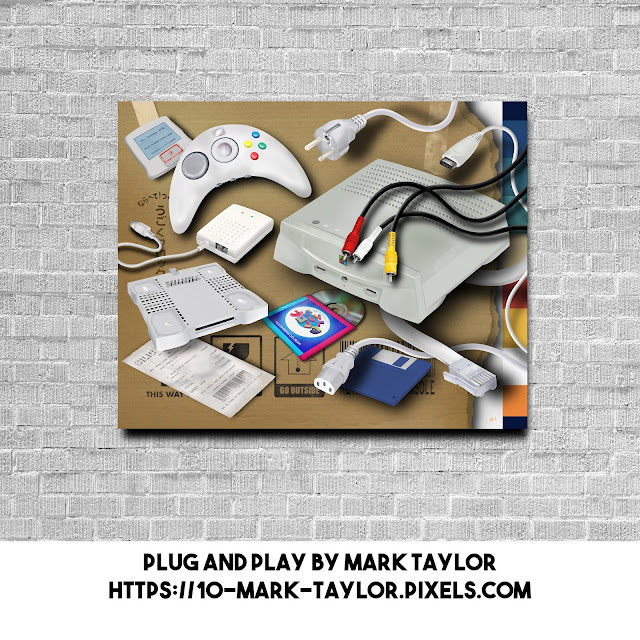 |
| Plug and Play by Mark Taylor - so many accessories and it was still a flop. Highly collectible today, as should this artwork be!† |
A lot of artists I have spoken to recently have told me how much they fear being completely displaced by AI in the future, and especially those who work in fields that could become much more susceptible to automation. If you are working on repetitive patterns and AI is then able to recreate that pattern, it probably is more suited to carrying out repetitive tasks more efficiently, but as I said earlier, repetition doesnít always come out perfectly with AI, at least not yet.
This is something that todayís
artists could eventually embrace. If the initial work to create the pattern or
design is carrie



